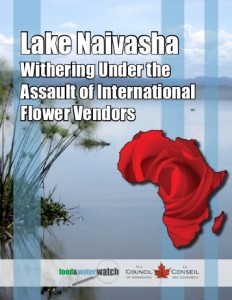Water for Flowers
Its waters covering about 50 square miles5 of Kenya‚ Great Rift Valley, Lake Naivasha (elevation 6,200 feet) sits 62 miles north of Nairobi. Communities thrived along its shores 4,000 years ago. The Maasai people long grazed their cattle along the lake‚ banks.6
Lake Naivasha: Withering Under the Assault of International Flower Vendors
DOWNLOAD PDF
Its waters covering about 50 square miles5 of Kenya‚ Great Rift Valley, Lake Naivasha (elevation 6,200 feet) sits 62 miles north of Nairobi. Communities thrived along its shores 4,000 years ago. The Maasai people long grazed their cattle along the lake‚ banks.6
In 1904, under a treaty with the British colonial government, the Maasai agreed to make way for ranchers. “As Kenya neared independ-ence, the government embarked on a series of settlement schemes designed to increase agricultural output…This sequence of events underlies much of the land ownership and land use in and around Naivasha today. Many of the large horticultural and floricultural farms surrounding the lake were once farms owned by European settlers, but are now owned by their descendents, wealthy Africans and/or international interests. On the slopes of the lake‚ basin, the aftermath of the resettlement schemes continues to unfold, with land being increasingly subdivided as Kenya‚ population continues to grow.” 7
Access to Lake Naivasha itself is a bit complicated, says Ouma Oloo. Historically there was public access to the lake, but the private landowners have closed most of that. The Lake Naivasha Riparian Association once was known as the Lake Naivasha Landowners Association, which really means the flower farms that now own much of the land around the lake.8 Without adequate lake access, poor residents are left to get their water from communal taps and form long lines to do so. Cattle herders, such as the Maasai, can only bring their cows to a small section of the lake where there is still public access — sharing access with women washing their clothes, hippos, and flamingoes.9
It is within this pattern of development that the international vegetable and flower farms formed. One of those is Sher Agencies, the world‚ largest supplier and producer of roses. Its greenhouses in Kenya, Ethiopia, and the Netherlands produce 600 million roses a year. The company is in the process of moving from Dutch ownership to control by India-based Karuthuri Networks, which announced its $50 million purchase of Sher in February 2007.10



